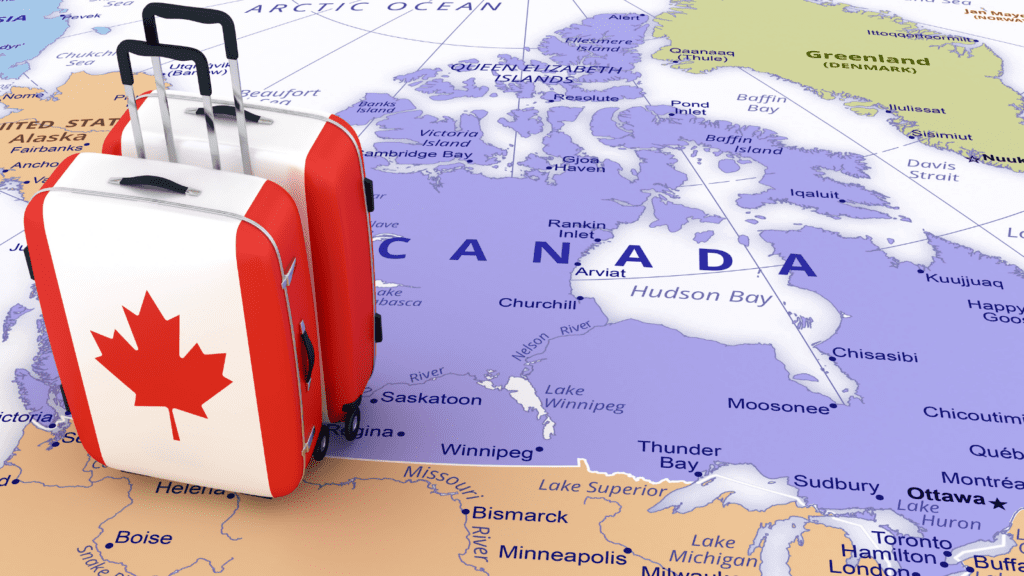Our step-by-step guide to moving to Canada from the US has been created in response to the growing number of Americans looking to make the move to Canada in recent months. As a US citizen, you have many options for Canadian immigration, including the best pathways to permanent residency in Canada.
Why Consider Moving to Canada?
In this section, we will explore why Canada should be at the top of your list if you are considering moving from the United States. From job opportunities to healthcare systems and everything in between, Canada has plenty to offer for those looking for a fresh start.
1. Economic stability:
Canada’s economy is consistently ranked among the top in the world by organizations such as the World Bank and Forbes magazine. With low unemployment rates and a stable banking system, Canada provides a safe haven for individuals seeking better job prospects. The country has also been witnessing steady economic growth over the years, making it an ideal location for professionals looking to advance their careers.
2. Welcoming immigration policies:
Canada has always had a reputation for being welcoming towards immigrants from all over the world. The country values diversity and encourages newcomers to bring their unique skills and experiences to contribute towards its development. Unlike many other countries that have strict immigration policies, Canada offers various pathways for skilled workers, entrepreneurs, investors, students, and family members to become permanent residents.
3. High standard of living:
Canada consistently ranks high on global indexes measuring quality of life factors such as education systems, healthcare facilities, and safety; however, Canada prioritizes the overall well-being of its residents through social programs, community engagement, and a healthy work-life balance, contributing to a fulfilling and contented lifestyle.
Understanding the Immigration Process: Key Terms and Concepts
The immigration process can be a complex and overwhelming journey, especially when moving from one country to another. As you begin to explore your options for immigrating to Canada from the United States, it’s important to understand some key terms and concepts that are essential in navigating this process. In this section, we’ll dive deeper into these terms and explain their significance.
1. Permanent Residency (PR)
Permanent residency is a status granted to foreign nationals who have been approved by the Canadian government to live and work in Canada on a permanent basis. This means that you can stay in Canada indefinitely as long as you meet certain residency requirements. PR holders also have access to many rights and benefits, such as healthcare coverage and the ability to apply for Canadian citizenship after meeting specific criteria.
2. Express Entry
Express Entry is an online system used by Immigration, Refugees and Citizenship Canada (IRCC) to manage applications for permanent residency under three federal economic immigration programs: the Federal Skilled Worker Program, Federal Skilled Trades Program, and Canadian Experience Class. Candidates must meet specific eligibility criteria based on factors such as age, education, work experience, language proficiency, etc., and are then given points through the Comprehensive Ranking System (CRS). Those with the highest CRS scores receive invitations to apply for permanent residency.
3. Provincial Nominee Programs (PNPs)
PNPs are different immigration programs run by individual provinces or territories within Canada that allow them to nominate candidates for permanent residency based on their specific labor market needs
Immigration Options for Work in Canada:
Immigration to Canada for work purposes is a popular option among individuals looking for new job opportunities and career growth. With its strong economy, diverse industries, and welcoming immigration policies, Canada has become a top destination for immigrants seeking employment.
- Express Entry System:
The Express Entry system is an online application management system used by the Canadian government to manage applications for permanent residency from skilled workers. It is a points-based system that evaluates candidates based on factors such as age, education, work experience, language proficiency, and adaptability. - Provincial Nominee Programs (PNPs):
Provincial Nominee Programs are tailored immigration streams designed by each province or territory in Canada to meet their specific economic needs. These programs allow provinces and territories to select candidates who have the skills and experience required in their local labor market.
Temporary Work Permits
Temporary Work Permits are a popular option for individuals looking to move to Canada from the United States. These permits allow foreign workers to temporarily work in Canada for a specific employer and occupation.
Eligibility for Temporary Work Permits:
In order to be eligible for a Temporary Work Permit, the applicant must have a job offer from a Canadian employer and meet certain criteria set by Immigration, Refugees and Citizenship Canada (IRCC). Some of the key eligibility requirements include:
– A valid job offer from a Canadian employer with a positive Labour Market Impact Assessment (LMIA) or an exemption
– Proof of qualifications and skills required for the job
– Evidence of ties to home country such as family, property ownership, etc.
– Willingness and ability to leave Canada once the permit expires
Express Entry System
The Express Entry System is a popular immigration option for individuals looking to move to Canada from the United States. It is a points-based system that evaluates potential immigrants based on their age, education, work experience, language proficiency, and other factors.
To be eligible for the Express Entry System, applicants must first create an online profile and meet the minimum requirements for one of the following federal economic immigration programs:
1. Federal Skilled Worker Program (FSWP): This program is designed for skilled workers with at least one year of full-time work experience in a high-demand occupation. Applicants must also score at least 67 points out of 100 on the Comprehensive Ranking System (CRS) to be considered.
2. Federal Skilled Trades Program (FSTP): This program targets skilled tradespeople who have at least two years of work experience in a specific trade and meet certain language requirements.
3. Canadian Experience Class (CEC): This program is for individuals who have gained at least one year of skilled work experience in Canada within the past three years.
Once an applicant meets the eligibility criteria for one of these programs, their profile will be entered into the Express Entry pool along with other candidates. Profiles are ranked against each other using the CRS system, which assigns points based on factors such as age, education level, language skills, and work experience.
Provincial Nominee Programs
- Provincial Nominee Programs (PNPs) are a popular route for individuals looking to immigrate to Canada from the United States. These programs are designed by individual provinces and territories in collaboration with the federal government to address their specific labor market needs and economic priorities.
- Under these programs, provinces and territories have the authority to nominate eligible foreign workers, entrepreneurs, and students who have the skills, education, and work experience required to contribute to their local economy. In order to be eligible for a PNP, applicants must first meet the criteria set by the province or territory they wish to settle in.
- Each province and territory has its own unique selection criteria and program streams under which they nominate candidates. Some PNPs may require candidates to have a valid job offer from an employer in that particular province or demonstrate ties to the region through previous education or employment experience. Others may have specific eligibility requirements based on occupation, language proficiency, age, or other factors.
- One of the main benefits of PNPs is that they provide a pathway for individuals who may not meet the requirements of other federal immigration programs such as Express Entry or Family Sponsorship. Additionally, PNPs often have faster processing times compared to federal programs as they are able to directly select and nominate candidates without having them compete with others in a pool of applicants.
conclusion
The decision to move from the United States to Canada is not just a change in geography; it’s an investment in economic stability, inclusivity, and an enhanced quality of life. Our guide aims to empower you with valuable insights into the immigration process, emphasizing pathways that align with your aspirations. As you contemplate this transformative journey, remember that the true value lies in the opportunities for growth, diverse experiences, and the chance to contribute to Canada’s vibrant tapestry. Wishing you a rewarding and fulfilling adventure as you make Canada your new home!
Frequently Asked Questions (FAQs)
- Can I move to Canada without a visa?
- Yes, you can stay in Canada visa-free for six months with a US passport.
- What are the job prospects for newcomers in Canada?
- Canada’s job market is diverse; however, researching your specific field and networking can enhance your employment prospects.
- Is healthcare in Canada free?
- Canada offers universal healthcare, but understanding the nuances of provincial health programs is essential.
- Can I retain my U.S. citizenship while becoming a Canadian citizen?
- Yes, Canada allows dual citizenship, providing an opportunity to retain your U.S. citizenship.
- How can I overcome inadmissibility challenges?
- Seeking professional advice and following the proper channels is key to overcoming inadmissibility hurdles.








